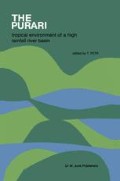Abstract
It has been estimated that Wabo Dam and its associated reservoir would trap 92% of the sediment load of the Purari River over a 150-year period (SMECNK 1977). The effects of removing such a large proportion of the sediment supply from the river are considerable and the change in sediment supply is the key to environmental impact assessment of the Purari Hydroelectric Scheme.
Access this chapter
Tax calculation will be finalised at checkout
Purchases are for personal use only
Preview
Unable to display preview. Download preview PDF.
References
Bagnold, R.A., 1977. Bed load transport by natural rivers. Water Resour. Res. 13: 303 - 312.
Blong, R.J., 1981. Stability analysis of Chim Shale mudslides, Papua New Guinea. Int. Assoc. Hydrol. Sci. Publ. 132: 42 — 66.
Borland, W.M. and C.R. Miller, 1960. Distribution of sediment in large reservoirs. Trans. Am. Soc. Civ. Engrs. 125: 166 -180.
Brune, G.M., 1953. Trap efficiency of reservoirs. Trans. Am. Geophys. Un. 34: 407 - 418.
Byrne, G.M., M.M. Ghiyandiwe and P.M. James, 1978. Ok Tedi landslide study. Geological Survey of Papua New Guinea Report 78/3. Port Moresby, P.N.G.
Carey, W.C., 1977. The Gulf of Papua — a future megapolis. In: J.H. Winslow (ed.), The Melanesian Environment, pp. 309 - 313. A.N.U. Press, Canberra.
Goldman, C.R., R.W. Hoffman and A. Allison, 1975. Environmental studies design, Purari River development. Report to United Nations Development Program and the Papua New Guinea Government. Ecological Research Associates, Davis, California.
Gottschalk, L.C., 1964. Sedimentation, Part I: Reservoir sedimentation. In: V.T. Chow (ed.), Handbook of Applied Hydrology, pp. 17/1-17/34. McGraw Hill, New York.
Hydrologic Engineering Centre, 1977. HEC-6, scour and deposition in rivers and reservoirs, user’s manual. U.S. Army Corps of Engineers.Industrial Bank of Japan, 1975. Report by Purari Industrial Survey Mission. Tokyo.
Klaer, W. and M. Kreiter, 1981. The importance of the humus on the stability of slopes and soils in the highlands of Papua New Guinea. Paper presented at the Symposium on Erosion and Sediment Transport in Pacific Rim Steeplands, Christchurch, New Zealand.
Koelzer, V.A. and J.M. Lara, 1958. Density and compaction rates of deposited sediment. Proc. Am. Soc. Civ. Engrs., J. Hydraul. Div. 84: 1603/1-1603/15.
Löffler, E., 1977. Geomorphology of Papua New Guinea. A.N.U. Press, Canberra
Meyer-Peter. E. and R. Muller, 1948. Formulas for bed-load transport. Int. Assoc. for Hydraulic Structures Res., 2nd Meeting, Stockholm, Sweden, pp. 39 — 64.
Pain, C.F. and R.J. Blong, 1979. The distribution of tephras in the Papua New Guinea highlands. Search 10: 228 — 230.
Pain, C.F. and J.M. Bowler, 1973. Denundation following the November 1970 earthquake at Madang, Papua New Guinea. Z. f. Geomorph. N.F. 18: 92 -104.
Pickup, G., 1977. Computer simulation of the impact of the Wabo Hydroelectric Scheme on the sediment balance of the lower Purari. In: T. Petr (ed.), Purari River (Wabo) Hydroelectric Scheme Environmental Studies, Vol. 2. Office of Environment and Conservation, Waigani, Papua New Guinea.
Pickup, G., R.J. Higgins and R.F. Warner, 1981. Erosion and sediment yield in Fly River drainage basins, Papua New Guinea. Int. Assoc. Sci. Hydrol. Pub. 132: 438 — 456.
Pickup, G. and R.F. Warner, in preparation. Geomorphology of tropical rivers. II. Channel ad- justment to sediment load and discharge in the Fly and lower Purari, Papua New Guinea.
Ruxton, B.P., 1971. Slopewash under mature primary rainforest in northern Papua. In: J.N. Jennings and J.A. Mabbutt (eds.), Landform Studies from Australia and New Guinea, pp. 85 — 94. A.N.U. Press, Canberra.
Snowy Mountains Engineering Corporation - Nippon Koei (SMEC-NK), 1977. Purari River Wabo Power Project feasibility report. 8 volumes.
Toffaletti, W.B., 1969. Definitive computations of sand discharge in rivers. Proc. Am. Soc. Civ. Engrs., J. Hydraul. Div. 95: 225 - 248.
Turvey, N.D., 1974. Nutrient cycling under tropical rain forest in central Papua. Dept. of Geography, Univ. of Papua New Guinea. Occasional Paper, 10.
Wood, A.W., 1983. Soil types and traditional soil management in the Purari catchment. This volume, chapter I, 5.
Editor information
Editors and Affiliations
Rights and permissions
Copyright information
© 1983 Dr W. Junk Publishers, The Hague
About this chapter
Cite this chapter
Pickup, G. (1983). Sedimentation processes in the Purari River upstream of the delta. In: Petr, T. (eds) The Purari — tropical environment of a high rainfall river basin. Monographiae Biologicae, vol 51. Springer, Dordrecht. https://doi.org/10.1007/978-94-009-7263-6_11
Download citation
DOI: https://doi.org/10.1007/978-94-009-7263-6_11
Publisher Name: Springer, Dordrecht
Print ISBN: 978-94-009-7265-0
Online ISBN: 978-94-009-7263-6
eBook Packages: Springer Book Archive

